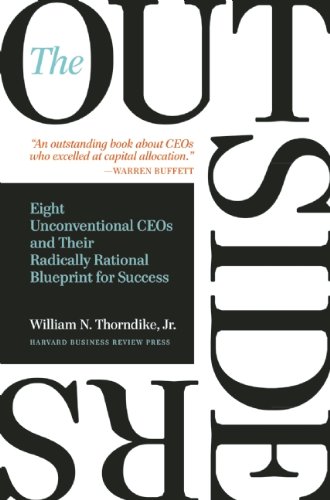

This article is an excerpt from the Shortform summary of "The Outsiders" by William N. Thorndike, Jr. Shortform has the world's best summaries of books you should be reading.
Like this article? Sign up for a free trial here .
Does diversifying your portfolio really work? How can Warren Buffett’s diversification advice help you grow your business?
Like most successful CEOs, Warren Buffett understands the value of diversification. Read about how Warren Buffett’s diversification of his company, Berkshire Hathaway, and how having a diverse portfolio helped the company grow with Buffett as CEO.
Throughout the 1970s and 1980s, Buffett thus began investing in high-quality, enduring companies, such as the Washington Post, GEICO, and General Foods. He both made minority investments and purchased companies outright, such as with See’s Candies and the Nebraska Furniture Mart.
As a large diversified company, Buffett also had more control over his insurance companies’ underwriting to maximize profitability. When premium pricing was low, Buffett’s insurance companies would underwrite fewer premiums; when pricing was high, it would take advantage by underwriting multiple-fold more in premiums. For instance, between 1984 to 1986, premiums grew sixfold, then shrank 73% by 1989. It’d be difficult for an independent public insurer to do the same, since its investors expect smooth performance.
How Does Warren Buffett’s Diversification Strategy Work?
Warren Buffett’s diversification strategy is something he worked over the course of several decades. As a result, he built a large and diverse business portfolio. Read below about his investment style and views on acquiring and maintaining new stocks and businesses.
A Wide Range of Investment Options
Having had extensive experience in investing before starting Berkshire Hathaway, Buffett had a wider range of investment options than most CEOs. Typical CEOs only look within their immediate industry. In contrast, this mean that Warren Buffett’s diversification strategy could be put into place. Buffett has made investments in a vast array of industries (from beverages to industrials). Even his investments take a wide range of flavors, including investments in both private and public companies, both minority investments and complete acquisitions, and at times making big bets in bonds and currencies.
Warren Buffett: Diversification and Portfolio Management
Along with Warren Buffett’s diversification techniques, he also had to develop a strategy for keeping and maintaining this diverse portfolio. Amongst portfolio management concerns are 1) how many stocks an investor owns and 2) how long he holds them.
Buffett believes that great companies are rare, and that concentrated portfolios generate great returns. Berkshire has advised students that if they were only limited to 20 total investments throughout their career, they would drastically improve their performance. As a result, and as part of Warren Buffett’s diversification strategy, Berkshire is famously concentrated among its holdings. The top five holdings typically make up 60-80% of Berkshire’s value. At one time, Buffett had 40% invested in American Express.
In contrast, mutual funds are often made up of hundreds of stocks, with no single stock making up more than a few percentage points. This is one way to invest, but it doesn’t align with Warren Buffett’s diversification strategy.
Buffett also holds stocks for a very long time—his top holdings have been held for over 20 years. This lack of transaction activity allows compound interest to continue generating massive returns without leakage through taxes. In contrast, mutual funds often hold for less than one year.
Inversely, Buffett aims for Berkshire shareholders to be long-term partners as well. He has never split Berkshire shares, which currently trade at hundreds of thousands of dollars.
Decentralization of Operations
Operations are an essential part of Warren Buffett’s diversification strategy. Despite Berkshire’s companies employing 270,000 people, its headquarters has only 23 people.
Warren Buffett is famously hands-off with his management of owned companies, believing this reduces overhead and encourages entrepreneurship. When he buys a company, he leaves the management team in place and rarely makes changes. Then Buffett doesn’t expect the CEO to call him unless Buffett can help. There are no regular budget meetings. As long as the company performs, Buffett leaves them alone. This leaves him free to pursue investments and manage the portfolio.
This is a major part of Berkshire’s appeal when sellers consider being acquired by Berkshire—unlike a private equity buyer or larger company, Berkshire will allow management to continue running the business. This gives Berkshire an advantage in appealing to certain types of sellers.
Centralization of Investments
Part of Warren Buffett’s diversification of his business is his ability to keep decisions close. Like most other outsider CEOs, Buffett is completely centralized in capital allocations. All capital flows to headquarters to allocate. Buffett personally takes charge of negotiations, and he does not rely on investment bankers or business development to make deals.
Buffett also believes in having a relatively small board, and requiring all board directors to have a personal stake in decisions. This means:
- A meaningful investment of personal capital into the business
- No insurance
- Avoiding fees that represent a large percent of the director’s income
This aligns board members much better with the performance of the business. In contrast, board members who have little ownership in the business, have insurance that protects them from downside, and are paid large fees are far less interested in guiding the company correctly
As you can see, Warren Buffett’s diversification strategy helped build Berkshire Hathaway into a large and successful company. Diversification is key to building strong businesses.

———End of Preview———
Like what you just read? Read the rest of the world's best summary of William N. Thorndike, Jr's "The Outsiders" at Shortform .
Here's what you'll find in our full The Outsiders summary :
- What great CEOs like Warren Buffett do that average CEOs don't
- How to master the art of capital allocation
- How to be a great manager that your team is excited to work with






